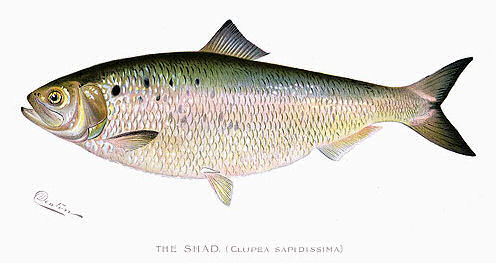
Shadbush in Bloom!
Each spring, there are certain signs that, no matter what the weather's like, spring is coming. The sparse white bloom of eastern Shadbush (Amelanchier canadensis) also known as Shadblow, Juneberry and Serviceberry, is one I look for.
Shadbush is a small, understory deciduous tree, ranging from well drained hillsides to wetland. Along field edges, however, it can grow to 25 feet tall, and is easily recognized. (I bet you'll them now, too!)
This small tree's five-petaled flowers come out before leaves grow. They show up quite early in the forest, before black cherry or dogwood are blooming, and sometimes they even beat the daffodils.
 Shadbush is one of a few fishy plants of spring.
Shadbush is one of a few fishy plants of spring.
It got its name because it blooms around the same time shad return to their spawning grounds, swimming up into streams from the Atlantic Coast, even as far as the Great Lakes. That makes them similar to some trout, but they're not related. In fact, the American shad, "the fish that fed the nation's founders", was once one of our most important food sources, arriving just in time as food stores ran low at the end of a long winter. So the blooming shadblow was more than just a pretty sight, in meant food on the table!
OK, But WHAT DO THAT HAVE TO DO WITH TROUT?
 Shadbush is one of a few fishy plants of spring.
Shadbush is one of a few fishy plants of spring.It got its name because it blooms around the same time shad return to their spawning grounds, swimming up into streams from the Atlantic Coast, even as far as the Great Lakes. That makes them similar to some trout, but they're not related. In fact, the American shad, "the fish that fed the nation's founders", was once one of our most important food sources, arriving just in time as food stores ran low at the end of a long winter. So the blooming shadblow was more than just a pretty sight, in meant food on the table!
 |
| Guess what month Juneberry fruits show up? |
Amelanchiers are members of the rose family, which includes apple, cherry and hawthorn trees. Their fruits are flavorful and edible, but seedy! Birds and other wildlife usually get to them first. Native Americans relied on shadbush fruits as food and medicine. As fall comes on the Shadbush stars again, with leaves turning deep red to orange. See you notice them on your next hike upstream this spring! (Look for them along Upper Taughannock Creek, Salmon Creek, Upper Buttermilk or at Upper Treman State Park where your trout were released!)

No comments:
Post a Comment